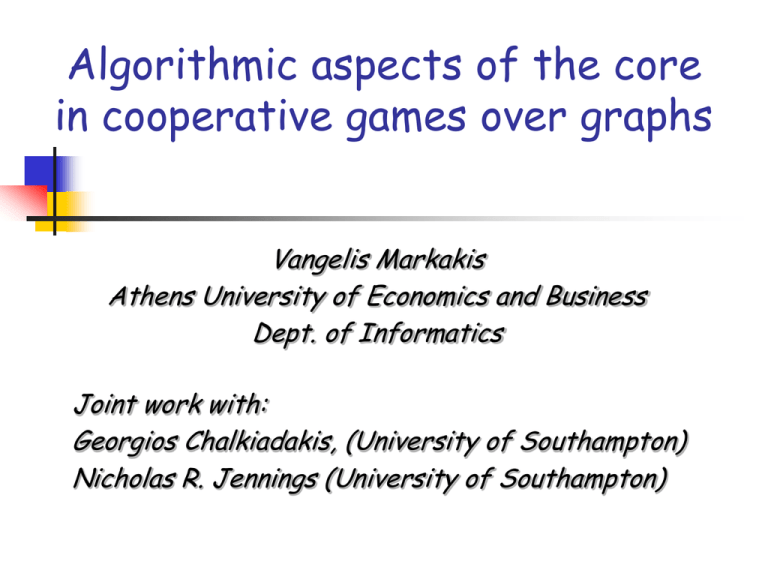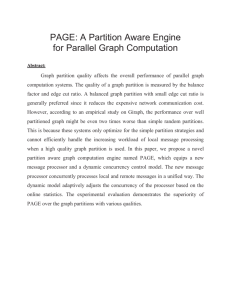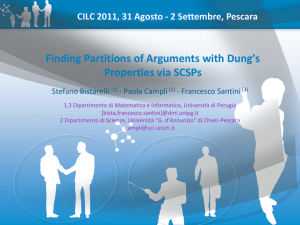Algorithmic Aspects of the Core in Cooperative Games over Graphs.
advertisement

Algorithmic aspects of the core
in cooperative games over graphs
Vangelis Markakis
Athens University of Economics and Business
Dept. of Informatics
Joint work with:
Georgios Chalkiadakis, (University of Southampton)
Nicholas R. Jennings (University of Southampton)
Our focus
Cooperative games with restrictions on the set of
allowable coalitions
Restrictions defined via a graph structure
Computational Complexity issues
Can we compute a core element or decide if an element
belongs to the core with efficient algorithms?
Outline
Cooperative games with restricted cooperation
TU games on lines, trees, and rings
Algorithmic and NP-hardness results
Extensions to Partition Function Games
Conclusions / Future work
3
The standard model of
TU games
Set of players N = {1,…,n}
A TU (Transferable Utility) game is a pair
Value of coalition S:
Usually superadditivity is also assumed (we will
not insist on this here)
4
The standard model of
TU games
Let Π = {C1,…,Ck} be a partition of N
Ι(Π) = imputations of Π:
Core:
5
TU games defined on
graph structures
In some settings not all coalitions are allowed to form
[Aumann-Dreze ’74, Myerson ’77]
Physical limitations on communication,
Legal banishments,
Players with similar expertise need not participate in the same
coalition
…
Cooperation structures suggested so far:
Hierarchies (directed trees), general graphs (directed, undirected),
antimatroids [van den Brink ’08]
Applications: sensor networks, telecommunication networks,
various multi-agent and multi-robot systems
6
TU games defined on
graph structures
Let G be an undirected graph
Feasible coalitions:
F(G) = connected coalitions, i.e., all sets S such that the
subgraph induced by S is connected
Feasible partitions:
P(G) = partitions into feasible coalitions
New version of core:
7
TU games defined on
graph structures
1
●
Example:
3
2
●
●
4
● 5● 6● 7●
●
●
8
-{1,2,3,5,8}F(G), {2,3,5,8} F(G)
9
●
10
- ({2,4,5,6,7}, {1,3,8,9,10,11}) P(G)
●11
-({1,2,4}, {5,6,7}, {1,3,8,9,10,11}) P(G)
8
Algorithmic issues
Computational problems:
CORE-NONEMPTINESS: Given a game on a graph
G, is the core of the game non-empty?
CORE-FIND: Given a game, find an element in the
core or output that the core is empty.
CORE-MEMBERSHIP: Given (Π,x), does it belong
to the core?
Polynomial time algorithms / impossibility results ?
9
The state of the art
Lines Superadd. trees General trees Superadd General
Rings
Rings
NONO(1)
EMPTINESS
O(1)
O(1)
P
?
FIND
P
P
NP-hard
P
?
MEMBER
SHIP
P
? (conjecture:
co-NPcomplete)
co-NPcomplete
P
P
Note: For many classes of general TU-games without restrictions,
the problems are known to be NP-hard or co-NP-hard
10
Algorithmic results
An algorithm for CORE-FIND on trees [Demange ’04]
Pick a vertex r as the root (think of the tree as oriented
from the root downwards to the leaves)
Step 1: We compute a guarantee level gi for every node i.
For leaves, gi is the reservation value.
For an internal node i,
where max taken over subtrees starting at i
Step 2: Start from root and go downwards. Pick the
coalition T (subtree) where the root achieves its guarantee
level. Continue downwards in same manner for remaining
nodes, not included in T.
11
Algorithmic results
Note: For superadditive games on a line, player i
simply receives its marginal contribution of being
added to coalition {1,…,i-1}
Theorem [Demange ’04]: The outcome of the
algorithm belongs to the core.
12
Algorithmic results
(Worst case) running time analysis of the algorithm
Theorem:
i.
For superadditive games on a line the
complexity of the algorithm is O(n)
ii.
For non-superadditive games on a line, the
complexity is O(n2)
iii.
For superadditive games on a tree, the
complexity is O(n)
iv.
For non-superadditive games on a tree the
algorithm requires exponential time
13
Hardness results
Theorem:
For general games on trees, CORE-FIND
is NP-hard and CORE-MEMBERSHIP is co-NPcomplete, even when the tree is a star.
Proof: By reductions from the PARTITION problem:
Given n numbers a1,…,an is there a subset S such that
14
Hardness results–Proof Sketch
Given n numbers a1,…,an, we construct a tree with n
leaves
0
●
1 ● 2●
…
● n●
n-1
Finding an element in the core corresponds to finding the “right”
subset of the leaves that will join the root
15
Outline
Cooperative games with restricted cooperation
TU games on lines, trees, and rings
Algorithmic and NP-hardness results
Extensions to Partition Function Games
Conclusions / Future work
16
Partition Function Games
Externalities in cooperative games [Thrall, Lucas ’63]
The value of a coalition may depend on the partitioning of
the other players
V(S, Π): value of S in partition Π
How should a deviating coalition reason about the
behavior of the non-deviators?
17
Partition Function Games
Pessimistic approach: assume the rest of the
players will partition themselves so as to hurt you
the most
Optimistic approach: assume the rest of the
players will form a partition, most profitable for
you.
Other approaches have also been considered, each
resulting in a different notion of core [Koczy ’07]
18
PFGs on graphs
Theorem: For PFGs on trees,
(i)
The pessimistic core is always non-empty.
(ii) There exist games where the optimistic
core is empty.
19
Extensions and future work
Resolve open questions regarding the core
Polynomial time approximation algorithms
for the core?
Other cooperative solution concepts?
Other classes of graphs or cooperation
structures?
Bayesian Partition Function games
20
Thank you!











